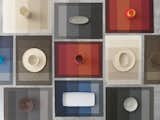Tempo is a minimalist series of lighting archetypes built into a single system designed by Barcelona-based studio Lievore Altherr for Vibia. Tempo is the result of a challenging idea: different Lighting Archetypes built into a single system. We analyzed and defined archetypes from different cultures and regions, concentrated on three, reduced these to their most essential expression and finally brought them together into a system of fixing elements such as hanging versions and different arms. The challenge was to make it work as one single system, but maintain the identity of each archetype – finding a common balance within a family of individuals. Lightness, the interplay of opacity, translucence and transparency, and atmosphere are central themes for the Tempo collection. Three different glass shapes offer varied lighting effects – one like a classic bulb under a reflector meant to send light to the floor; one like the classic opaline globe reinterpreted with a soft shape and blurred effect that mixes general with floor oriented light; and another is a reduction of the angular opaline lamps offering a diffuse general light. All of them respond to different expressions and lighting situations, and can be used with diverse pendant and arm solutions. The structure can be interpreted in graphite black, broken white, matte gold and a soft grey-green. Together with the lamp shades the system allows endless interpretations.











